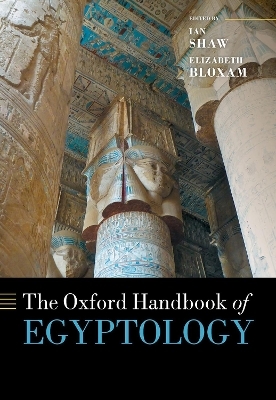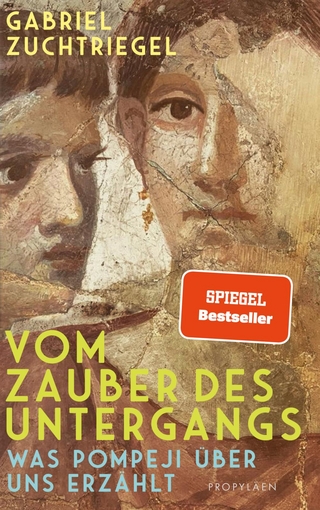
The Oxford Handbook of Egyptology
Oxford University Press (Verlag)
978-0-19-927187-0 (ISBN)
The Oxford Handbook of Egyptology offers a comprehensive survey of the entire study of ancient Egypt from prehistory through to the end of the Roman period. It seeks to place Egyptology within its theoretical, methodological, and historical contexts, indicating how the subject has evolved and discussing its distinctive contemporary problems, issues, and potential.
Transcending conventional boundaries between archaeological and ancient textual analysis, the volume brings together 63 chapters that range widely across archaeological, philological, and cultural sub-disciplines, highlighting the extent to which Egyptology as a subject has diversified and stressing the need for it to seek multidisciplinary methods and broader collaborations if it is to remain contemporary and relevant. Organized into ten parts, it offers a comprehensive synthesis of the various sub-topics and specializations that make up the field as a whole, from the historical and geographical perspectives that have influenced its development and current characteristics, to aspects of museology and conservation, and from materials and technology - as evidenced in domestic architecture and religious and funerary items - to textual and iconographic approaches to Egyptian culture. Authoritative yet accessible, it serves not only as an invaluable reference work for scholars and students working within the discipline, but also as a gateway into Egyptology for classicists, archaeologists, anthropologists, sociologists, and linguists.
Ian Shaw is Reader in Egyptian Archaeology at the University of Liverpool, as well as Visiting Professor in Egyptology at the Northeast Normal University in Changchun, China. He has excavated and surveyed at the cities of Amarna, Gurob and Memphis, the Valley of the Kings, and the ancient quarrying and mining sites of Hatnub, Wadi el-Hudi, Gebel el-Asr, and Wadi Hammamat. His publications include the edited volumes The Oxford History of Ancient Egypt (OUP, 2000) and Ancient Egyptian Materials and Technology (with Paul T. Nicholson; CUP, 2000), as well as The British Museum Dictionary of Ancient Egypt (with Paul T. Nicholson; British Museum Press, 1995) and Ancient Egyptian Technology and Innovation: Transformations in Pharaonic Material Culture (Bloomsbury, 2012). Elizabeth Bloxam is currently Visiting Professor in Egyptology at the Northeast Normal University in Changchun, China and has held an Honorary Research Associate post at University College London for the last ten years. Her research interests centre on ancient Egyptian society and technology with a particular focus on the social relationships and organization surrounding resource procurement in Egypt and the Eastern Mediterranean. She has directed multidisciplinary surveys and excavations in several ancient quarrying and mining sites in Egypt, including a current project in the Wadi Hammamat, and has published widely in international journals including World Archaeology, Journal of Social Archaeology, Cambridge Archaeological Journal, Journal of Egyptian Archaeology, and Archéo-Nil.
Frontmatter
List of Figures
List of Tables
List of Contributors
0: Elizabeth Bloxam and Ian Shaw: Introduction: Egyptology in the twenty-first century: an historical curiosity or setting new agendas in multidisciplinary research?
I. Egyptology: perspectives on a discipline
1: Andrew Bednarski: The nature and history of Egyptology
2: David Wengrow: Egyptology and cognate disciplines
3: Li Xiaodong: Egyptology in China
4: Florian Ebeling: Reception of ancient Egypt
II. The natural environment: studying the macro and micro-level
5: Karl W. Butzer: Landscapes and environmental history of the Nile valley: a critical review and prospectus
6: Claire Malleson: Flora of ancient Egypt
7: Salima Ikram: Ancient Egyptian fauna
8: Elizabeth Bloxam: The mineral world: studying landscapes of procurement
III. Archaeological landscapes: surveying, characterizing, and managing
9: David Jeffreys: Mapping and topography
10: Adel Kelany: Recording rock inscriptions: methods and challenges from an Egyptian perspective
11: Elizabeth Bloxam and Adel Kelany: Cultural Heritage Management in Egypt: community-based strategies, problems, and possibilities
12: Ana Tavares: Methods of site survey and excavation in Egypt
IV. Material culture
13: Paul T. Nicholson: Introduction: studying materials and technology
14: Ian Shaw: Settlement archaeology and the contextualization of domestic artefacts
15: Bettina Bader: Ancient Egyptian pottery
16: Jan Picton, Janet Johnstone, and Ivor Pridden: Textiles
17: Aidan Dodson: Funerary equipment
18: Regine Schulz: Seals and scarabs
19: Salima Ikram: Mummies and physical anthropology
20: Corinna Rossi: Ancient Egyptian architecture
21: Campbell Price: Statuary
22: J. Brett McClain: Relief sculpture
V. Egypt and its neighbours: revisiting cross-border relationships
23: Robert Morkot: Africa south of Egypt
24: Linda Hulin: The Libyans
25: Carolyn Routledge: Western Asia
26: Jacke Phillips: The Aegean
VI. Egyptian history: exploring sources and interpretative frameworks
27: Stan Hendrickx: The Predynastic period
28: Ludwig D. Morenz: The Early Dynastic Period
29: Nigel Strudwick: The Old Kingdom and First Intermediate Period
30: Wolfram Grajetzki: The Middle Kingdom and Second Intermediate Period
31: Colleen Manassa Darnell: The New Kingdom
32: David A. Aston: The Third Intermediate Period
33: Tony Leahy: Egypt in the Late Period
34: Khaled Essam Ismail: The Ptolemaic and Roman periods
VII. Society and culture: textual and iconographic approaches
35: Wolfram Grajetzki: National administration
36: Christopher J. Eyre: Local administration
37: Sandra Lippert: Law
38: Morris L. Bierbrier: Genealogies
39: Susanne Bickel: Gods, mythology, and cosmology
40: Richard Wilkinson: Symbolism and religious iconography
41: Alexandra von Lieven: Theology
42: Eltayeb Abbas: Funerary beliefs and practices
VIII. Scripts and philology
43: Andréas Stauder: Scripts
44: Julie Stauder-Porchet: Lexicography
45: Sami Uljas: Grammar
46: Andréas Stauder: History of the Egyptian language
IX. Textual genres: current positions and future directions
47: Jacqueline E. Jay: Orality and literacy in ancient Egypt
48: Ronald J. Leprohon: Historical texts
49: Denise Doxey: Autobiographical' texts
50: Bill Manley: Literary texts
51: John Gee: Socio-economic texts
52: Annette Imhausen: Mathematical texts
53: Rune Nyord: Texts for healing and protection
54: Deborah Sweeney: Letters
55: Richard Jasnow: Demotic texts
56: Terry Wilfong: Coptic texts
57: John Coleman Darnell: Rock art, rock inscriptions, and graffiti
58: Olaf E. Kaper: Ptolemaic and Roman temple texts
59: Ian S. Moyer: Greek and Latin sources
X. Museology and conservation
60: Campbell Price: Museum collections
61: Maher A. Eissa and Ashraf el-Senussi: Egyptian museums and storehouses
62: Deborah Schorsch: Conservation in Egyptological museum collections
Endmatter
Index
| Erscheinungsdatum | 03.01.2020 |
|---|---|
| Reihe/Serie | Oxford Handbooks |
| Zusatzinfo | 134 black-and-white illustrations |
| Verlagsort | Oxford |
| Sprache | englisch |
| Maße | 180 x 254 mm |
| Gewicht | 1876 g |
| Themenwelt | Geisteswissenschaften ► Archäologie |
| Geschichte ► Allgemeine Geschichte ► Vor- und Frühgeschichte | |
| Geschichte ► Allgemeine Geschichte ► Altertum / Antike | |
| Geisteswissenschaften ► Sprach- / Literaturwissenschaft ► Anglistik / Amerikanistik | |
| Geisteswissenschaften ► Sprach- / Literaturwissenschaft ► Literaturwissenschaft | |
| ISBN-10 | 0-19-927187-9 / 0199271879 |
| ISBN-13 | 978-0-19-927187-0 / 9780199271870 |
| Zustand | Neuware |
| Informationen gemäß Produktsicherheitsverordnung (GPSR) | |
| Haben Sie eine Frage zum Produkt? |
aus dem Bereich


